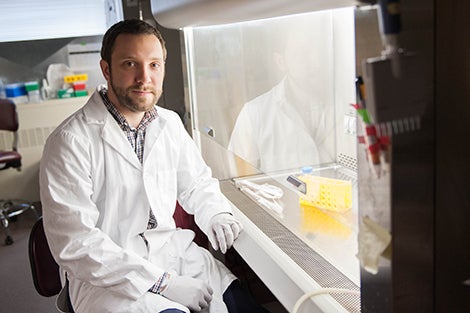May 21, 2015 – On a Friday afternoon in May, Peter Wagner was about to give his dissertation defense. Quan Lu, associate professor of environmental genetics and pathophysiology—introducing Peter before a group of about 50 of his fellow students, faculty, friends, and family—flashed an on-screen photo of Peter as a young boy with a snake draped around his neck. Then came photos of Peter outdoors—in mountains, near lakes, under blue skies.
The pictures showcased Peter’s deep interest in the environment, which—along with his background in bench science—led him in 2010 to Lu’s lab at Harvard T.H. Chan School of Public Health, where he studied the brain’s molecular response to lead exposure. This May, Peter will graduate with a PhD in biological sciences in public health.
“I consider Peter the ideal student. He’s smart, hardworking, and passionate about what he does,” said Lu.
Seminal moment
In 8th grade, as a reporter for his middle school newspaper at the International School of Brussels, in Belgium, Peter interviewed Jane Goodall—a world expert on chimpanzees and an ardent conservationist—who was visiting the school. “It was a magical and seminal moment in which the environment suddenly became very important to me,” he said. When Peter’s father, a U.S. diplomat, was transferred and the family moved to Germany, Peter found that his new school—the Berlin-Brandenburg International School—didn’t have an environmental club, so he started one himself.
Peter went on to study environmental biology at Columbia University in New York. While there, he discovered a penchant for lab work while working on his senior thesis, on bacteria in soil that can change the chemical form of arsenic, in the lab of Brian Mailloux. After graduation he spent two years in Finland—where his mother is from and where he was born—as a research assistant in the lab of Leena Peltonen-Palotie, a world-renowned geneticist, at the Institute for Molecular Medicine Finland in Helsinki. He learned much about population genetics and analytical methods. But he was looking for a way to combine his environmental background from Columbia with the genomics he learned in Finland—and that led him to Harvard Chan School.
“The School is probably the only place in the world where you can unify laboratory environmental exposures and human population genetics,” said Peter. He cited the value of being able to use data from the epidemiological studies managed by David Christiani, Elkan Blout Professor of Environmental Genetics, as well as the opportunity to participate in cutting-edge science in Lu’s lab.
Looking at lead
At his dissertation defense, Peter outlined some of the well-known negative effects of lead on children’s development, such as lower IQs, increases in ADHD, and increased antisocial or delinquent behavior. “Even low amounts of lead can cause these effects,” Peter said. Although the danger of lead is well known, it remains an environmental problem. In the U.S., for example, although lead in paint was banned in 1978, and lead in gasoline was mostly phased out in the 1980s, there is still lead in the environment. In urban areas in particular, lead-based paint flakes off windows and gets into household dust. In Guiyu, China, a town with a large electronic waste recycling plant, children living nearby have significantly higher blood lead levels than those living in a neighboring town.
Peter has researched the impact of lead on the brain from various angles. In the lab, he has looked at the genomic impact of lead on human neural stem cells in the brain. He has also looked at epidemiological data from 465 mother-child pairs participating in the ELEMENT (Early Life Exposure in Mexico to Environmental Toxicants) cohort in Mexico City, where people are exposed to lead from smog and lead glazes on dishes. Data from that cohort included lead levels in the children’s blood over time as well as information on their mental and psychomotor development.
Peter’s research suggests that some people have a genetic variant that actually helps protect them against lead’s harmful effects. This discovery, he said, “could help us better understand the body’s innate defenses to lead, and perhaps we could target those defenses so as to improve children’s outcomes when they’re exposed to lead.”
In the community—and beyond
During his time at Harvard Chan, Peter has been a coordinator for the Roxbury Prep Tutoring Program run by the School’s Office of Diversity and Inclusion. Through the program, Harvard Chan students tutor students at Roxbury Prep Charter School, a middle school in nearby Mission Hill, in math and science. “Everybody gets a lot out of it,” he said.
After graduation, Peter will work as a life sciences consultant at a small company in Boston. Now that he’s preparing to graduate, he offers a scientist’s perspective on the benefits of studying at the School. “Often times people think it’s strange that we do so much basic science at the School of Public Health, but it’s really a wonderful environment to do it in,” he said. “Everybody here wants to try and fix some kind of large public health problem. It’s so easy to get tunnel vision when you’re in a science lab and working at the bench. Being at a School where you’re looking at health problems from every angle imaginable really helps you keep a fresh perspective.”
photo: Emily Cuccarese
